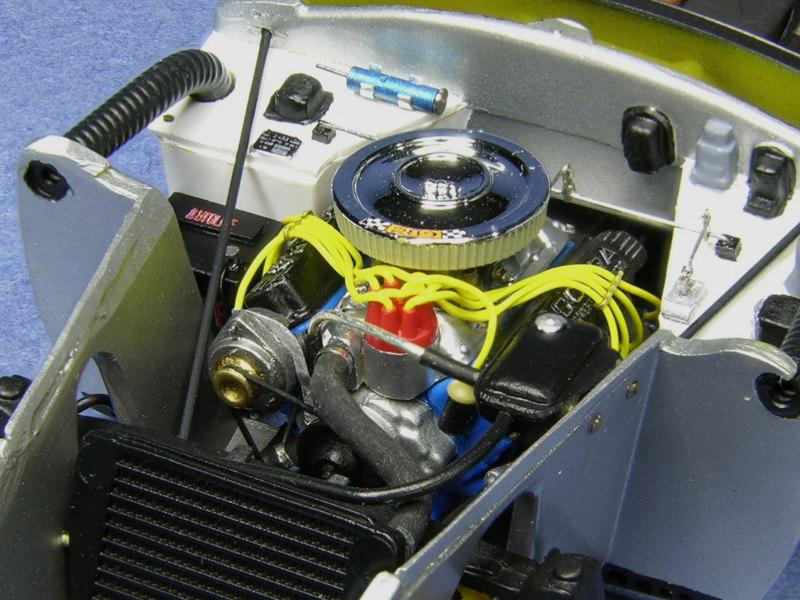-
Posts
9,217 -
Joined
-
Last visited
Content Type
Profiles
Forums
Events
Gallery
Everything posted by peteski
-

The downside of the hobby - what annoys you?
peteski replied to Mike C's topic in The Off-Topic Lounge
Yes, that is the typical PCB drill with a 0.125 (1/8) inch shank. That's what I'm familiar with. You are absolutely correct. And they usually rotate at very high speeds when drilling FR4 glass/epoxy composite PC board material (which is abrasive to the tools). Even so, for decades I have been using those PCB drill bits down to #85 (0.28mm) to hand-drill (holding the 1/8" shank between my fingers) holes in plastic. I have broken few over time, but not often. I also use them in my drill press with almost no breakage. -

The downside of the hobby - what annoys you?
peteski replied to Mike C's topic in The Off-Topic Lounge
I have never seen PCB drill bits with such large shanks. All the miniature ones I have ever dealt with have 1/8" shafts. A #85 bit on a 6.3mm diameter shank would look sort of strange to me. I even have PCB bits which are larger than 1/8" but they still have 1/8" shafts. -

The downside of the hobby - what annoys you?
peteski replied to Mike C's topic in The Off-Topic Lounge
Unfortunately to work so well they have to be made from very hard material which is brittle. Those bits were designed for use in precision machines (not hand-drilling) which use them for drilling thousands of holes in PC boards. Yes, they survive much longer used in a drill press. I use those bits as much as I can and have plenty of spares. Large part of why PC board bits work so well is because they are sharpened to split point. If you could find very small HSS bits which were sharpened to spit point those would work just as well on softer materials like plastic aluminum or brass as PC board drill bits. Split point bits do not wander and cut the material better than bits sharpened to a standard point. I have larger HSS bits with split points and those work very well. -
So much for La-Z-Boy having reputation as a excellent quality furniture company.
-
Yes, it answered my question - thanks. It just seemed odd the way you phrased your message. It was as if someone else brought this thread from the grave and you were surprised that the old thread was revived. At leas that is how I interpreted it. Yet, you were the erson who brought it back. And FYI, I never randomly scroll through the messages here. I have very specific and deliberate method of viewing the forum. I look separately into only sections which interest me (I skip some sections altogether). I have the forums sorted by the newest threads on top. In each section I only look at new messages (since my last visit), But again, not all new messages. If there is an active thread which I looked into earlier but which doesn't interest me, I don't even bother to open it. When done looking through all the new messages in threads which interest me, I just mark that entire forum section as read, so I'll have a baseline next time I visit. I never scroll thru the forum sections to look at any older threads. I only look for older threads when I search for a specific info which I hope to find in the message archive.
-
NEVER ASSUME ANYTHING, especially with the low-IQ "certified technicians" servicing your car.
-
So why did *YOU* fish it out of the archive? The post before yours was 12 years ago! BTW, checking Dr Cranky's profile, he last visited October 22, 2016.
-

Favourite Rims
peteski replied to Falcon Ranchero's topic in General Automotive Talk (Trucks and Cars)
Were those actual wheels or just hubcaps (wheel covers over steely wheels)? Yes, those Centerlines look really good. Back in the day I had them on my '76 Camaro. I also want to mention that I strongly dislike any black colored wheels. With the black tires that combo looks too drab to me. Wheels need some contrast from the tire. -
Sounds like it power washed it! That's not cool.
-
Well then I guess the admins have to intervene here. They can do all sorts of "magic".
-
Interesting. I would thin that Revell uses the the typical (easy to remove) vacuum metalizing method to "chrome" their plastic parts. When you were sanding the metallic layer off was there a noticeably thick layer of metal or the metalization came off fairly easily?
-
While the "chrome" most model companies use to make plastic look like chrome is actually very thin layer of aluminum over high gloss undercoat. Aluminum is not a very robust metal so it can be easily removed using Lye-based liquids (like LA Awesome) and some even use chlorine bleach. But some manufacturers use electroplating method to deposit thicker layer of another metal over the plastic. Those are basically impervious to most chemicals. Trumpeter is one of those companies which uses this method. What company makes the Stacy David Hiboy?
-
What specific kind/brand of foil are you using? "Slick surface" is sort of strange statement. Slick might mean waxed (not just glossy paint). Foils used to represent chrome trim on models all have pressure sensitive adhesive (like any other sticker). In my experience stickers adhere best to glossy surfaces.
-

Turning Gold Chrome to Regular Chrome ?
peteski replied to Jon Haigwood's topic in Model Building Questions and Answers
Standard "gold chrome" used on plastic kits is the regular (vacuum metalized) layer of (silver) aluminum sprayed with transparent yellow/orange clear top coat to make the silver look gold. If you try stripping just that top clear layer you will also damage the delicate silver layer under it. As I see it, the only way to de-gold is to fully strip the parts and re-coat them with a silver color finish of your choice. -

Source for white metal requested
peteski replied to fcriscuo's topic in Model Building Questions and Answers
Thanks for the explanation, but to me in order for the "solder" to run like a liquid along the kit's parts indicates that the "solder's" melting temperature has to be quite bit lower than the kit's parts themselves. If l liquid metal actual wets another metal, there is a great amount of heat transfer going on between them (for the wetting to occur). I guess looking at the "big picture" there really is no point trying to get into the technical details. Looks like that technique works and I learned something new. -

Realistic metallic silver on 1/24 car body?
peteski replied to Pete53's topic in Model Building Questions and Answers
As you mentioned, many metallic paints (made specifically for models, automotive touch-up or just general purpose) have metallic particles too large to look in-scale on a model. Testors line of automotive colors hobby paints is one of the examples of out-of-scale metallic paint. Models painted with those paints look like the were coated with glitter. This is not very noticeable when the model is viewed in-person, but it really shows in close-up photos. Some hobby paint suppliers who blend their own paints (like CMW, Scale Finishes, Zero or Splash Paints) use fine metallic powders so their paints look in-scale on a model. -

Source for white metal requested
peteski replied to fcriscuo's topic in Model Building Questions and Answers
Good for you! I don't think many modelers have access to laser welders. CA or epoxy work well, but the joint strengths is nowhere as good as welding. Matt the technique you describe sounds more like brazing than soldering. https://en.wikipedia.org/wiki/Brazing Also, if the solder was the same stuff as the kit parts themselves, wouldn't that also start melting the kit parts?! I suspect the melting point of the solder is lower than the metal used for the kit. Don't you also need a soldering iron with adjustable temperature to keep it for getting too hot? -
I'll ask the obvious (since you didn't mention it): After you followed the password reset process (expecting an email in the email account tied to your forum account), did you check the SPAM folder for the password reset email?
-
That is a coverage of Topher's business which in todays world is a quickly vanishing service. But I do have to comment on whoever proofread the article. Gear made of acetone [sic]? Maybe they were thinking of "acetal" plastic? In either case, the gear in question appears to be made of Nylon, and even though Nylon is a durable plastic, it will eventually wear down (especially when it meshes with a metal worm). Maybe it was molded from inferior quality plastic, but it was not "acetone". When technical terms are used, someone with proper background should be proofreading it (yes, this type of problem shows up more and more often in printed media and spoken word). Sorry for the rant.
-

1/8th scale pullies ?
peteski replied to Jon Haigwood's topic in Model Building Questions and Answers
Yes, just remove the "belt" material from that pulley, create a groove, and make your own belt. in 1:8 scale that will look more realistic than a 3D printed belt. I have done this on kits as small as 1:43 and IMO it improves look of the engine compartment. If I can do this in 1:43, you should be able to pull it off in 1:8. -

Realistic metallic silver on 1/24 car body?
peteski replied to Pete53's topic in Model Building Questions and Answers
Tamiya Silver Plate is also metallic color with no apparent flakes. Also Tru-Color Aluminum is very smooth. Then there are various metallic shades from Alclad II. Those all supposed to represent bare metal surface (not a metallic paint with visible flakes). -

Source for white metal requested
peteski replied to fcriscuo's topic in Model Building Questions and Answers
I'm surprised that someone recommends soldering white-metal kits. If the kit is actually made of what in U.S. is usually called white-metal (or Zamak), that alloy does not solder easily. If the metal in question is Pewter (tin-based alloy), then it can be soldered, but it would be quite difficult to do without melting the parts themselves. If there is some new building technique out there, I have not heard about it. Tameo most likely uses some Peter alloy. I'm experienced in soldering (bot as a hobby and professionally) and I would not consider soldering Tameo kits. Here is some reading material on Zamak: https://en.wikipedia.org/wiki/Zamak And on Pewter: https://en.wikipedia.org/wiki/Pewter I have soldered kits made using photo-etched brass parts, but that is something all together different. Most modelers use either CA (superglue) or epoxy to build metal kits. My recommendation would be to forget soldering and use adhesives. -

New Help for 3D Printing: MESHY AI (works now)
peteski replied to KMcc's topic in General Automotive Talk (Trucks and Cars)
LOL, I thought your reply meant that you still couldn't watch the video, and not that you tried the technique and it didn't live up to your expectation. I guess if your worded your reply "Tried the technique. It's not there yet". I would have gotten the clue. -
That makes total sense. Quality of the JPG file (its compression) affects the file size.
-

New Help for 3D Printing: MESHY AI (works now)
peteski replied to KMcc's topic in General Automotive Talk (Trucks and Cars)
Worked for me. The The embedded video plays for me in Firefox on a PC. Here is a direct link https://youtu.be/MCbirH84sqE




